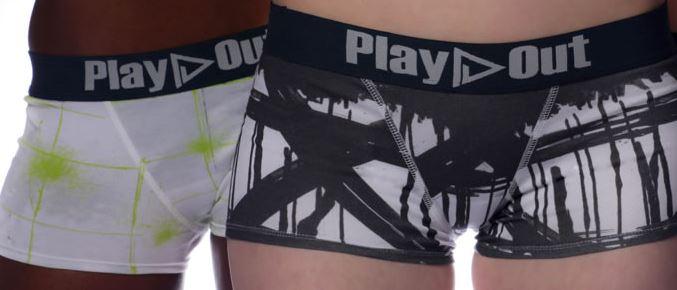
If the media is to be believed, Play Out gender stereotype-busting underwear is nothing short of revolutionary. "Gender Neutral Underwear Is Now A Thing—Would You Wear It?" asks HuffPo. "Gender Neutral Underwear is Here!" crows the National Review Online.
And you have to admit: The company has a hell of a pitch.
The designs are bold and, indeed, gender-neutral, meaning neither typically feminine, like flowers and polka dots, or typically masculine, like stripes or plaid. Abby Sugar and Sylvie Lardeux, who are partners both in business and romantically, created the company. Sugar told MailOnline they started Play Out because they were looking for underwear that was “less stereotypically feminine.”
“When we came out with our first cut, we had a lot of men and genderqueer individuals very excited for our underwear as well, so we consciously design both cuts to fit all people. You absolutely do not have to be gay to wear our undies.”
Sugar also noted that most underwear is designed “very specifically to attract the male gaze." But Play Out has a different approach:
“We want people to feel cool, happy and sexy wearing our underwear—but to feel that way for themselves, and not necessarily to please someone else.”
These words are the perfect descriptors for the fabric choices. For example, the most popular pattern, called "Wired," looks like the motherboard of a computer. According to Play Out’s website:
“No matter your gender identification, we consciously design everything—from the styling, coloring, and both cuts—to be appealing to every gender. We have had people of all gender presentations and identifications wear both styles of underwear.”
This is a noble intent; I’m a cisgender female, but I can see how gender queer (or “gender fluid,” as a friend of mine who is transgender likes to point out) people could see value in this product. Plus, why should underwear, of all things, perpetuate gender norms?
Still, style is one thing—but we can’t forget that underwear serves a very important purpose. So how does Play Out play out in terms of the functionality of the designs? Alas, not very well.
There are two cuts—boxer brief and full trunk cut. The boxer briefs have a flat front with no open fly, a more common design for female bodies, while the trunks have extra fabric in the front, a more typical design for male bodies.
The boxers aren't all that practical for guys, because they lack the fly men need to urinate without having to pull their pants down. What would guys who opt for this underwear do in a restroom—urinate in a stall instead of a urinal, because other dudes would stare at them and think "WTF?" At the same time, the trunks don't actually make sense anatomically for women. What are women supposed to do with that extra fabric used to support a man’s anatomy? Plus, most women wear fitted pants . . . so wouldn’t the extra fabric bunch up?
The designs themselves aren't really gender-neutral at all, then, making the company more about attention-grabbing style than real substance. And it's not as if such substance isn't possible.
Women, for instance, have long bought solid-colored boyshorts, which are gender-neutral without making any statement as such. Since 1992, Calvin Klein has been selling an entire line of androgynous underwear. While the designs aren't quite as playful as Play Out’s, the super-comfortable cotton undergarments feature wide waistbands (so nice) and come in various styles.
Play Out may have the marketing game down. But do we really need a company to pitch gender-neutral underwear, when there are other choices already available that don't make gender such a "thing" to begin with?






